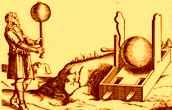
ELECTRICITY VOLUME TWO: EARLY HISTORY
How and when did we realize electricity exists, and how and when did we learn how to use it?
Electricity was discovered around 600 B.C., by a Greek named Thales, when he noticed that a piece of amber, when rubbed with wool, would pick up pieces of leaves and straw. For the next 2000 years we never got any further with it. The first modern scientist to experiment with electricity was William Gilbertt, in the late 1500s. He systematically rubbed all kinds of materials with all kinds of other materials to see if they would exhibit any powers of attraction. He classified things into "electrics" for those things that have an attractive force when rubbed, and "anelectrics" for those things that don't. He also noticed the differences between magnetic attractions and electrical attraction.

By the mid 1600's, Otto von Guerike had invented the first electrical generator. Otto was best known for his experiments with vacuum and pressure, including his most famous demonstration of holding two halves of an iron sphere together with vacuum, while horses were trying to pull them apart. His generator was a solid sulfur ball with an iron pipe through the middle. You would spin the sulfur ball with the pipe, and then rub you hand on the spinning ball. This would generate enough electricity to create small sparks. This is the first time that scientists put the attractive force together with the electricity that we think of today.

Over the next several hundred years, electrical generators became more and more refined. Most of them were various ways of spinning a glass object and rubbing it with wool. These were electrostatic generators. Static electricity is electricity in a still state. Charges are built up so that they can be let loose in an instant. Another important invention at this time was the Leyden jar, A device (essentially a capacitor) that could store electrical charges. With these two apparatuses, electrical experimentation took off. People hooked electricity up to anything and everything to see what happened. Electricity became entertainment. People would assemble a whole host of electrical toys and head for the lecture tour. They would make things spark, make bells ring, make things glow in the dark, attract things and repel things.

It was one of these traveling shows that got Benjamin Franklin interested in electricity. He started experimenting with it and made huge discoveries. He showed that despite the fact that some things were attracted to each other and other things repelled, there was only one electricity. He came up with the concept of positive and negative charges. And of course his most famous demonstration was to show that lightning was a form a electricity with his kite and key stunt. He not only invented the lightning rod, to help protect buildings from being struck but he also invented a warning system that would ring a bell when lightning was approaching. He one time had (in his words) "a party of pleasure on the banks of the Skuykil river, a turkey is to be killed... for dinner by the electrical shock, and roasted by the electrical jack (I'm not sure what that means) before a fire kindled by the electrified bottle (Leyden jar): when the healths of all the famous electricians in England, Holland, France and Germany are to be drank in electrified bumpers (pewter mugs given an electrical charge) under the discharge of guns from the electrical battery".

In the late 1700's, when the Italian scientist Luigi Galvani discovered that a jolt of electricity induced a twitch in a frog's leg, the whole world went ga-ga for medical electricity. There were no end of devices made to put electrical charges to or through animals and humans. Galvani's nephew Giovani Aldini got into the act by collecting cadavers of people who had died of disease and subjected them to electricity. He ran current through hands and arms and watched their movements. He eventually got a deal with the local government to use cadavers of freshly executed criminals for his experiment. One day he procured a freshly dead head and ran wires to each ear and watched the facial contortions. As luck would have it, they had a "two-for" day and that afternoon acquired a second head, put them ear to ear and ran current through both heads to see them twitch. No wonder Mary Shelley came up with the concept of Frankenstein. The crux of many of these experiments were to bring the dead back to life.

Physicians became "electrotherapists" and created one machine after another to cure one thing after another. Some machines would "electrify" an object that the patient would touch or sit on, and would build up a high electrical charge, similar to the generators you see in the science museums that you touch and your hair stands on end. There were also many machines that would actually run a current through the body for various cures. Maybe Eric "the dismissed" would care to elaborate on the subject as the owner of several medical "magnetos".
In any case, right up to the 1800's, most of the research of electricity yielded interesting but useless toys and bogus medical therapies. Stay tuned for the next installment containing modern electrical history.


0 Comments:
Post a Comment
<< Home